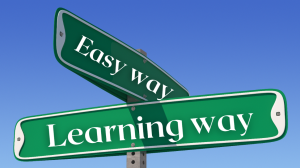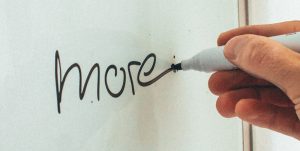TL;DR:
- Our grading habits can be inconsistent and have limited value in the learning process.
- The extrinsic motivation of grades often limits our students’ drive for deeper learning.
- Going gradeless is not a simple process, but a worthy one to help students reflect, listen to feedback, and grow.
In traditional education systems, grades have long been the primary measure of student success and progress. However, in recent years, educators and researchers have begun to question the efficacy and fairness of relying solely on grades as a measure of student achievement.
This has led to a growing movement towards ungrading, in which educators focus more on feedback, self-reflection, and skill-building rather than assigning grades to students. In this blog series, we will explore the benefits and challenges of breaking free from grades in education; I will share my own real-life experiences implementing this approach and provide resources and tips for those interested in trying it out in their classrooms.
It has been five years since I last blogged about going gradeless, and a lot has changed—I have changed the approach that I use to break free from grades. I am excited about sharing what I have learned along the way. Join us on this journey as we explore the possibilities of going gradeless and reimagining what education can look like.
Why do I go gradeless?
Let me start at the beginning. I started teaching in March of 1996 and didn’t start thinking about breaking free from grades until 2015. For almost 20 years, I did what everyone else always did. I gave assignments, collected their work, graded them, put their score into a grade book, and returned the assignment to them. But how I determined the grade varied. Sometimes grades were based on completion. The student received full credit if it was complete. However, if one part was missing or there was a blank, the assignment received no credit or there was an arbitrary deduction of points. Other times I used some basic math to determine a grade, dividing the number correct by the number possible to calculate a percentage.
 During that time, I noticed interesting things that students would do, and perhaps you’ve seen the same. Little things irked me, such as only completing graded work or completing work to get it done, not to learn. The students were efficient workers and played the game of school. Some played the game better by spending more time on work if it affected their grade. Other students needed help understanding the rules of the game. They spent too much time on assignments that were not graded and not enough on the ones I deemed worthy of a grade.
During that time, I noticed interesting things that students would do, and perhaps you’ve seen the same. Little things irked me, such as only completing graded work or completing work to get it done, not to learn. The students were efficient workers and played the game of school. Some played the game better by spending more time on work if it affected their grade. Other students needed help understanding the rules of the game. They spent too much time on assignments that were not graded and not enough on the ones I deemed worthy of a grade.
The students were efficient workers and played the game of school. Click To Tweet
Memorize and Purge
During my early years, multiple choice was king! Not because it was the best method to assess student understanding but because it was easy for me. It was quick, and there was no gray area between right and wrong. Honestly, I didn’t know how to assess the gray area, so I avoided it. Unknowingly, I was creating learners that knew nothing in-depth and retained a minimal amount of the inch-deep but vast amounts of information I gave them.
My students had to learn how to memorize and purge.
I wanted them to remember, but there’s only so much room in their working memory. I asked them to remember facts, names, definitions, labels, factoids, and other trivia. There was little for those disjointed thoughts to attach to, and then they were forgotten. In the next lesson, I repeated it. I was a master lecturer, armed with a bevy of examples, the ability to deliver a multitude of puns and dad jokes, and the strict behavior control of a tyrant.
Deeper learning is not comfortable.
I’m not an English teacher or a history teacher. I’m a science teacher; we like data and are linear thinkers. Even the things that involved writing were formulaic. Think about how most science teachers instruct students how to write a hypothesis. We make it into a formula, “If (insert independent variable) then (insert dependent variable) because of (insert reason).” Although I saw the value in learning at deeper levels, it was not my comfort zone. As a good scientist, I had seen and needed to act upon the data.
Although I saw the value in learning at deeper levels, it was not my comfort zone. Click To Tweet
I persisted in assessing my students at higher levels. I started giving my students volumes of written feedback in the form of red pen circles, drawings, and comments which all had to fit into the small margins of their written work. Sometimes I wrote questions that I wanted them to answer. I even told them that if they fixed these, they could turn them in for a better grade, but that rarely happened.
“Did you even look at the feedback?”
 A new wave of student responses appeared. I noticed that students ignored the feedback. Even though I spent hours upon hours writing the feedback, and my intentions were not to cut them down but to build them up, they didn’t look at it. Students threw the papers away in the garbage because they saw the grade. That bothered me. I remember telling the students they were not allowed to throw them out. The students listened and didn’t throw them out in MY garbage can, but I saw some in the hallway garbage can near my room. Kids saw assignments, learning, and grades as one-and-done. Students thought feedback was useless or pointless because the grade was (at least in their minds) final.
A new wave of student responses appeared. I noticed that students ignored the feedback. Even though I spent hours upon hours writing the feedback, and my intentions were not to cut them down but to build them up, they didn’t look at it. Students threw the papers away in the garbage because they saw the grade. That bothered me. I remember telling the students they were not allowed to throw them out. The students listened and didn’t throw them out in MY garbage can, but I saw some in the hallway garbage can near my room. Kids saw assignments, learning, and grades as one-and-done. Students thought feedback was useless or pointless because the grade was (at least in their minds) final.
A Self-Fulfilling Prophecy
 Students also classified themselves by the grades they received. They thought of themselves as “A” students or “F” students, or they would say things like I’m not good at science, I’m not good at math, or I’m not good at <insert class here>. You could see it before many of them walked in the door. Some students come to school on the first day with preconceived ideas about how it will go and what grade they will get. We didn’t even shake hands or say hello, yet they knew how they would do in this class. Just like an excellent self-fulfilling prophecy, those predictions came true. So how do we circumvent this? How do we get students to not see themselves as an “A” or an “F” student?
Students also classified themselves by the grades they received. They thought of themselves as “A” students or “F” students, or they would say things like I’m not good at science, I’m not good at math, or I’m not good at <insert class here>. You could see it before many of them walked in the door. Some students come to school on the first day with preconceived ideas about how it will go and what grade they will get. We didn’t even shake hands or say hello, yet they knew how they would do in this class. Just like an excellent self-fulfilling prophecy, those predictions came true. So how do we circumvent this? How do we get students to not see themselves as an “A” or an “F” student?
Mindset and Motivation
Grades create a fixed mindset and encourage students to focus on extrinsic motivators rather than intrinsic ones. Click To Tweet
Student mindsets drove me to help students see feedback as a step in the learning process rather than seeing it as a critique of themselves. The goal is for students to accept constructive criticism of their work and view it as a means to improve. I am a proponent of Carol Dweck and others’ work on a growth mindset. Grades create a fixed mindset and encourage students to focus on extrinsic motivators rather than intrinsic ones.
How do we improve student mindset and motivation? The impact of grades is a factor, but not how most think. How we assess, give feedback, and grade students are not the “magic bullet,” nor is it the only thing that will make life all the better for teachers and students, but it’s a step in the right direction.
[scroll down to keep reading]Progress Not Perfection
If you are a teacher who wants to go in this direction, please don’t expect it to go smoothly. Expect some bumps along the way because this is a process that, if you are like me, will take some time to figure out. My gradeless class has gone through numerous variations.
 My first blog, “52 weeks of going gradeless,” was about my first attempt, but I stopped prematurely at week 13 because it wasn’t working the way I wanted. I knew I needed an extensive overhaul of the process, but I needed more time. So begrudgingly, I reverted to grades for the remainder of the year. I wasn’t happy about it, but I needed to spend time researching the how and the why of the process. I went gradeless again the following year but armed with knowledge and experience. It was better than the first, but not perfect. It was progress rather than perfection—year after year, and each time came with improvements.
My first blog, “52 weeks of going gradeless,” was about my first attempt, but I stopped prematurely at week 13 because it wasn’t working the way I wanted. I knew I needed an extensive overhaul of the process, but I needed more time. So begrudgingly, I reverted to grades for the remainder of the year. I wasn’t happy about it, but I needed to spend time researching the how and the why of the process. I went gradeless again the following year but armed with knowledge and experience. It was better than the first, but not perfect. It was progress rather than perfection—year after year, and each time came with improvements.
So if you’re ready for this kind of constant tinkering, revising, and improving, welcome aboard! Read further if you see every step (backward or forward) as a step toward success. A growth mindset sees action as necessary to move forward because every mistake is a chance to learn, and every mistake is a chance to do better and to be better.
So here we go!
About Mike Szczepanik
Mike has been teaching Biology at Hilton High School since March 1996. During, the majority of those years teaching, he has taught AP Biology and Living Environment (NY’s at grade level biology). Mike is also his district’s 7-12 Science Program Coordinator.
Mike is a Teach Better Ambassador, in the Master Teacher Program and the Cornell Institute of Biology Teachers and has presented at numerous conferences and events including NSTA, NABT, STANYS, NYSCATE, and Master Teacher Program state conferences. Mike frequently attends Edcamps and helped start CoffeeEDU Rochester. In 2019, Mike was awarded the Outstanding Teaching Award for New York State by the National Association of Biology Teachers. Mike believes technology can augment and enhance learning, but it is not a replacement for an in-person hands-on classroom experience.
Likewise, students learn best when exposed to phenomena and discrepant events which force the learner to wrestle with the observed and the expected. Mike seeks to motivate learners not through grades but instead by creating an environment that gives the students autonomy, opportunities to show mastery, and collaborative purpose. To that end, he does not give grades to students but relies on self-assessment, peer assessment, and a lot of teacher feedback.





